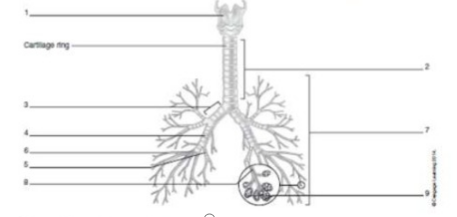Name the structure labeled #3 on the following image:

Primary bronchus
Respiratory bronchiole
Trachea
Secondary bronchus
The Correct Answer is A
A. Primary bronchus: The primary (main) bronchus is the first large airway branch that arises at the carina from the trachea and conducts air into each lung.
B. Respiratory bronchiole: Respiratory bronchioles are very small distal airways that contain alveoli and are deep within the lung parenchyma; they are much smaller than the structure shown near the main branch.
C. Trachea: The trachea is the central airway above the bifurcation (a vertical tube with cartilage rings); a label on the long central tube would indicate the trachea, not the branching airway.
D. Secondary bronchus: Secondary (lobar) bronchi are branches of the primary bronchus that lead to lung lobes; they are a generation distal to the main bronchus and are smaller than the primary bronchus.
Nursing Test Bank
Naxlex Comprehensive Predictor Exams
Related Questions
Correct Answer is C
Explanation
A. It depends on the complete lack of surface tension on the alveolar wall:Alveoli have surface tension; pulmonary surfactant reduces surface tension but does not eliminate it. Quiet expiration does not require an absence of surface tension.
B. It is driven by increased blood CO₂ levels:Elevated CO₂ increases the drive to breathe (affects ventilation rate), but quiet expiration itself is notactively driven by CO₂ -it is passive.
C. It is a passive process that depends on the relaxation of inspiratory muscles:Quiet expiration occurs when the diaphragm and external intercostals relax and elastic recoil of the lungs and chest wall returns air to atmosphere.
D. It requires contraction of abdominal wall muscles:Abdominal muscle contraction is used for forced expiration (e.g., coughing or heavy exercise), not normal quiet expiration.
Correct Answer is D
Explanation
A. Produce surfactant for the alveoli: Surfactant is produced by type II pneumocytes in the alveoli, not by tracheal cartilage.
B. Move mucus towards the alveoli using their cilia: Mucus is moved by ciliated epithelium (mucociliary escalator), not by cartilage rings.
C. Perform external respiration between air and blood: Gas exchange (external respiration) occurs in alveoli, not at the trachea.
D. Allow the trachea to always remain open for passage of air: The C-shaped cartilage rings provide rigid structural support and prevent tracheal collapse while allowing the posterior tracheal wall to flex -this maintains an open airway.
Whether you are a student looking to ace your exams or a practicing nurse seeking to enhance your expertise , our nursing education contents will empower you with the confidence and competence to make a difference in the lives of patients and become a respected leader in the healthcare field.
Visit Naxlex, invest in your future and unlock endless possibilities with our unparalleled nursing education contents today
Report Wrong Answer on the Current Question
Do you disagree with the answer? If yes, what is your expected answer? Explain.
Kindly be descriptive with the issue you are facing.
